What is the difference between Fresco Juices and Fresh Juices?
What is the difference between Fresco Juice vs. Fresh Juice?
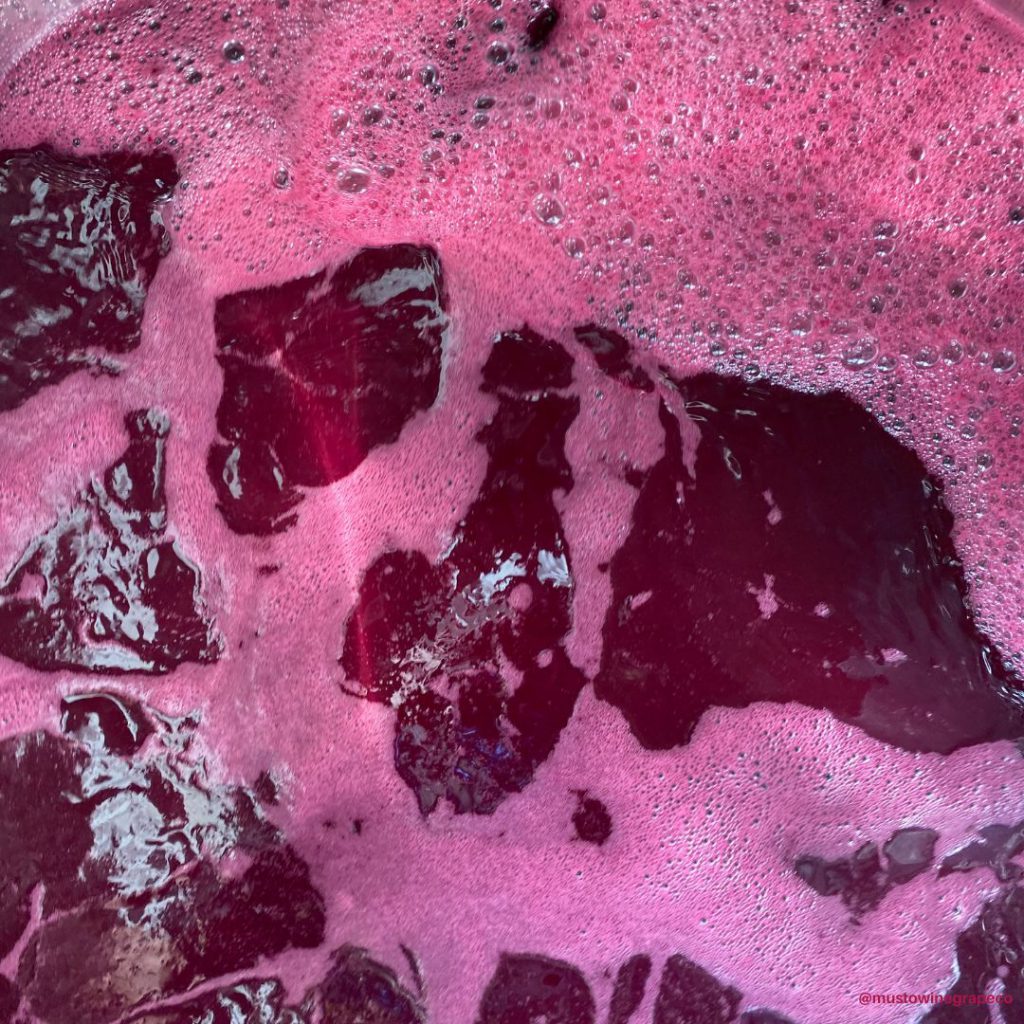
Fresco Juices:
Ever bake a cake from a box and it came out delicious? Did you know you could do the same with winemaking?
Mondiale Fresco is proud to be the only product to offer home winemakers their own vineyard in one unique package. Each pail of juice is pre-balanced and adjusted to ensure you have the best winemaking success possible. Just warm up the juice to fermentation temperature and watch it go.
What does “pre-balanced” and “adjusted” mean?
Every season Mother Nature gives us a different wine grape harvest. Some years the acid, pH, and sugars are all in line with each other. Most times they aren’t and there needs to be some slight adjustments made pre-fermentation to ensure top wine quality. The Fresco juices are adjusted so that the acid, pH, and sugar levels are all in balance with each other. This makes for an easier fermentation and, a very pleasing wine.
Depending on the varietal of wine you choose, enzymes and tannins might be added – all pre-measured, and ready-to-go, just open the packet and add to the pail. These add-ons help with wine clarity and mouthfeel, contributing to the “taste like made from scratch”, or in this case, as if fermented on the skins. The Fresco juices are the best juices to work with for busy winemakers. You get the juice warmed up, watch it ferment, age, and bottle.
Fresh Juices:
Fresh Juices come straight from the press!
Our fresh juices are from the grapes that are crushed, destemmed, and pressed right into the pails. For white wine, this is as if you were crushing and pressing yourself. For red wine the grapes are run through a heat or “hot” press in order to extract the color. Once these pails come up to temperature they can kick off because of the native yeast from the original grapes, or you can kill the native yeast and pitch your own yeast to ensure a more successful fermentation. Either way you are working with the fresh juice, not from concetrate. A delicous wine can be on your table as soon as Christmas!
So what is the difference?
The Fresh Juices are the straight from the press. The Fresco juices are straigth from the press, but pre-balanced and have a few additions made to them to make fermentation easier on the winemaker.
Either way you have delicious wine in the making!
To make an order please contact us via sales@juicegrape.com or call us at 877-812-1137, follow us on Facebook, Instagram, and Youtube, or check out the Harvest Tracker and Winemaker Blog on our website- juicegrape.com.
The Art and Joy of Curing Your Own Green Olives
Green olives, with their vibrant color and unique taste, have been a beloved ingredient in Mediterranean cuisine for centuries. Whether you enjoy them as a topping on your pizza, a flavorful addition to your salad, or as a tasty snack on their own, there’s something undeniably satisfying about their briny and slightly bitter flavor. While you can easily find jars of green olives at your local grocery store, there’s a special satisfaction in curing your own green olives at home. In this blog post, we’ll explore why you should consider taking up this age-old tradition and how to get started on your olive-curing journey.
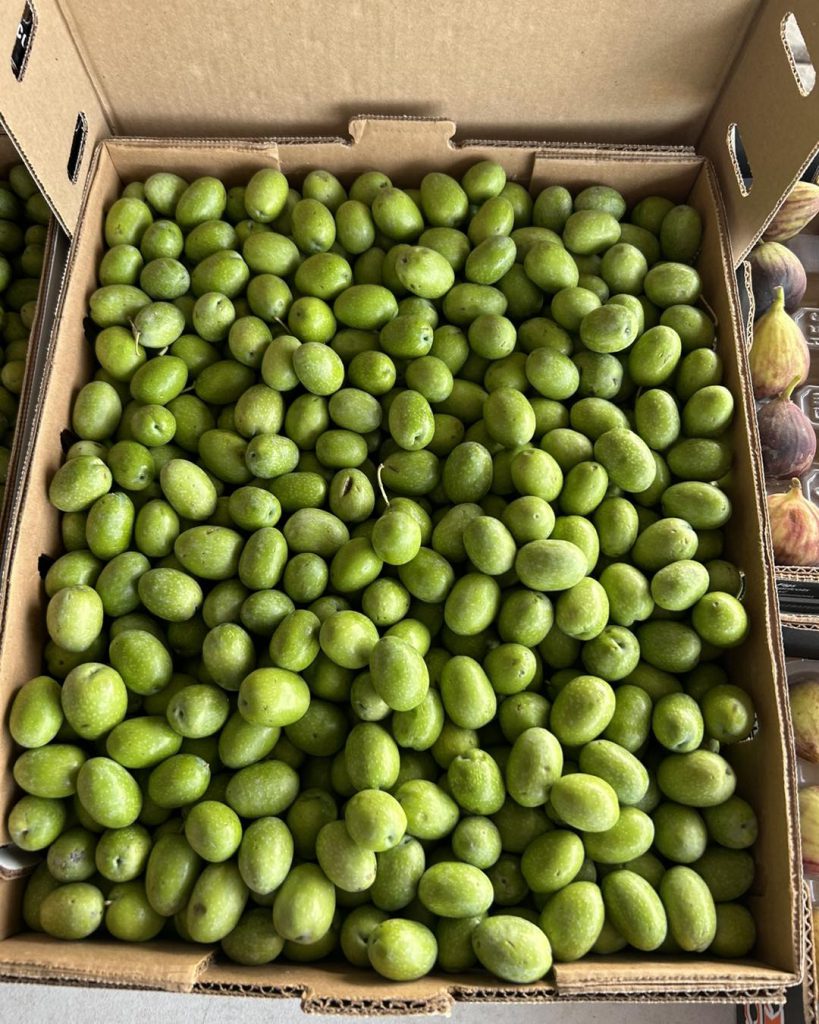
Unmatched Freshness:
One of the primary reasons to cure your own green olives is the unparalleled freshness you’ll achieve. When you buy olives from a store, they have often been processed, pasteurized, and stored for extended periods. This can affect their texture and flavor. However, when you cure your own olives, you have full control over the process, ensuring they are at their peak freshness.
Flavor Customization:
Curing your own olives allows you to experiment with various flavors and seasoning combinations. You can create olives that are perfectly tailored to your palate. Want them spicier? Add chili peppers. Prefer a milder taste? Opt for a simple brine with herbs. The possibilities are endless, and you can adapt the curing process to suit your taste preferences.
Sense of Accomplishment:
There’s an immense sense of accomplishment that comes from curing your own green olives. It’s a centuries-old tradition that connects you to the culinary heritage of the Mediterranean region. As you see your olives transform from raw, bitter fruit to delicious, briny morsels, you’ll gain a deeper appreciation for the art of food preservation.
Control Over Quality:
When you cure your own olives, you have control over the quality of the ingredients you use. You can select the best green olives available and choose high-quality olive oil, salt, and seasonings. This ensures that your final product is of the highest quality and free from any artificial additives or preservatives.
Sustainable and Cost-Effective:
Curing your own olives can also be a sustainable and cost-effective choice. You can source olives locally or even harvest them from your own olive tree if you have one. This reduces the carbon footprint associated with transportation and minimizes packaging waste. Plus, buying olives in bulk can be more economical in the long run.
Getting Started:
Now that you’re convinced of the merits of curing your own green olives, here’s a basic outline of how to get started:
- Choose Your Olives: Musto Wine Grape brings in fresh, firm green olives from California. We have two sizes of green olives, small and large in 16lb cases.
- Prepare a Brine: Create a brine solution by dissolving kosher salt in water. The exact proportions depend on your taste and the olives’ bitterness, but a common ratio is about 1/2 cup of salt per gallon of water.
- Curing Process: Soak your olives in the brine, ensuring they are submerged. This process can take several weeks to several months, depending on the size and bitterness of the olives.
- Flavoring: Experiment with flavorings such as herbs, garlic, lemon peel, or spices during the curing process.
- Storage: Once the olives reach your desired level of flavor and texture, store them in a cool, dark place, typically in jars filled with olive oil.
- Download: Download our favorite recipe by husband and wife winemaking duo Frank & AnnMarie Renaldi. Click the link to download their stpe by step direction –> How to Cure Your Own Olives
Conclusion:
Curing your own green olives is not only a rewarding culinary adventure but also a way to connect with tradition, savor unmatched freshness, and customize flavors to your liking. So, why not embark on this journey and experience the joy of curing your own green olives? It’s a delicious and satisfying endeavor that will elevate your appreciation for this Mediterranean gem.
Upgrade Your Winemaking Juice with the AllGrape Pack!
Upgrade Your Winemaking Juice with the AllGrape Pack!
Making from Fresh Juice or Wine Kits produces a fantastic wine, but can sometimes be lacking in tannins, color, flavor, and mouthfeel. This isn’t the winemaker’s fault, this is becasue these types of product do not get ample time on the grape skins to give the wine that extra kick of complexity.
Lucky for you, We Have a Solution! Enter the AllGrape Pack
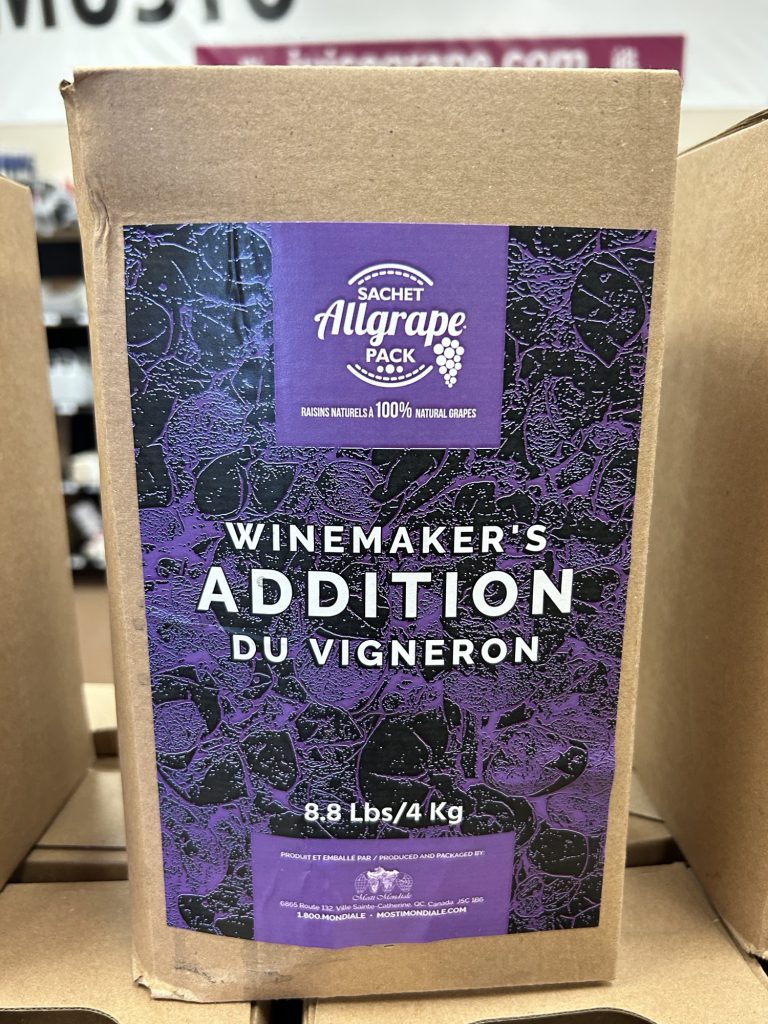
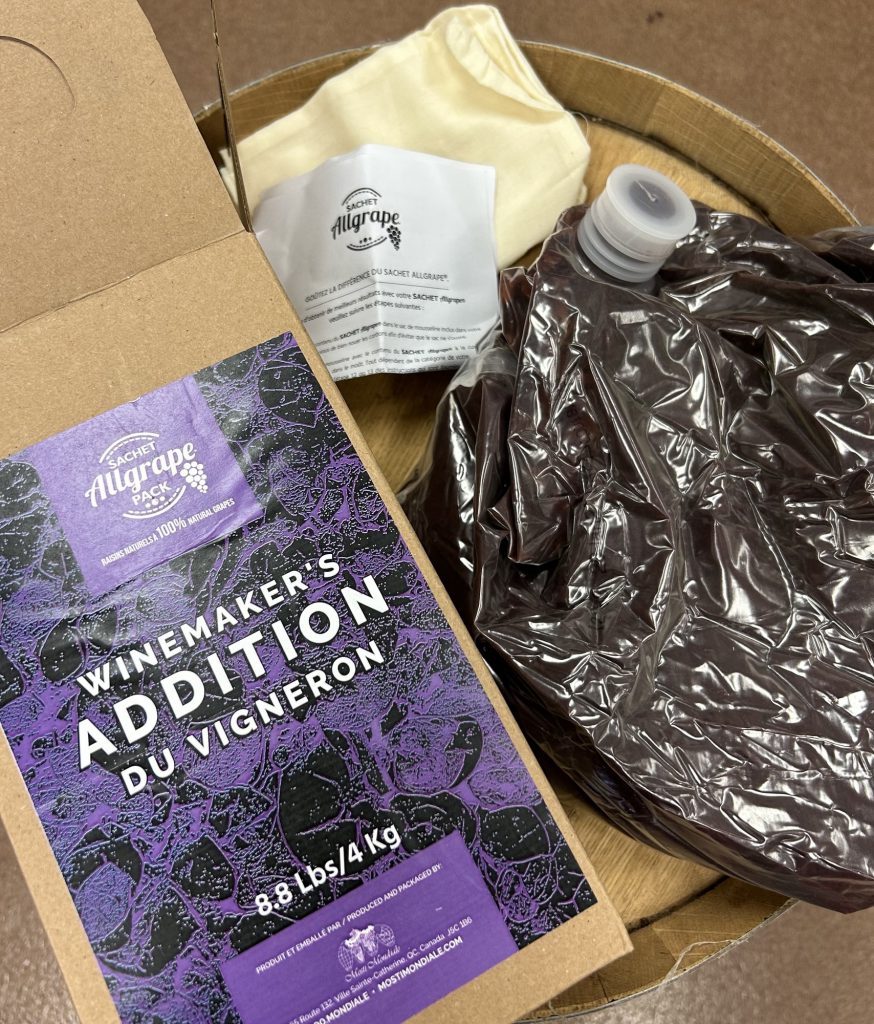
The AllGrape pack® contains 100% grapes, NO Fillers, NO sweeteners just 100% pasteurized crushed and destemmed grapes as “Mother Nature” intended!
Packed in a sterile, shelf-stable, bag in a box…taste the real Allgrape® difference.
Add it to your Fresh Wine Juice or Wine Kit and see a significant increase in the Flavor Profile, Tanninic Structure, and Mouthfeel in your Juice Wine!
It tastes as if you made wine from grapes!
Sam & Christina did an experiment with Chilean Merlot this Spring. We did one pail with the AllGrape pack and one pail without it. We couldn’t believe the difference! We believe in the product so much so that we discounted it so it’s easier to test out for yourselves. You won’t be disapointed. But hurry because this sale will only last until Novemeber!
FALL SPECIAL!
$33.00 – NOW $25.00
To make a wine juice order or if you have any questions about the AllGrape pack please contact us via sales@juicegrape.com or call us at 877-812-1137, follow us on Facebook, Instagram, and Youtube, or check out the Harvest Tracker and Winemaker Blog on our website- juicegrape.com.
Last Call for Fresco Juices! Grape & Juice Availability for 9/29-10/1
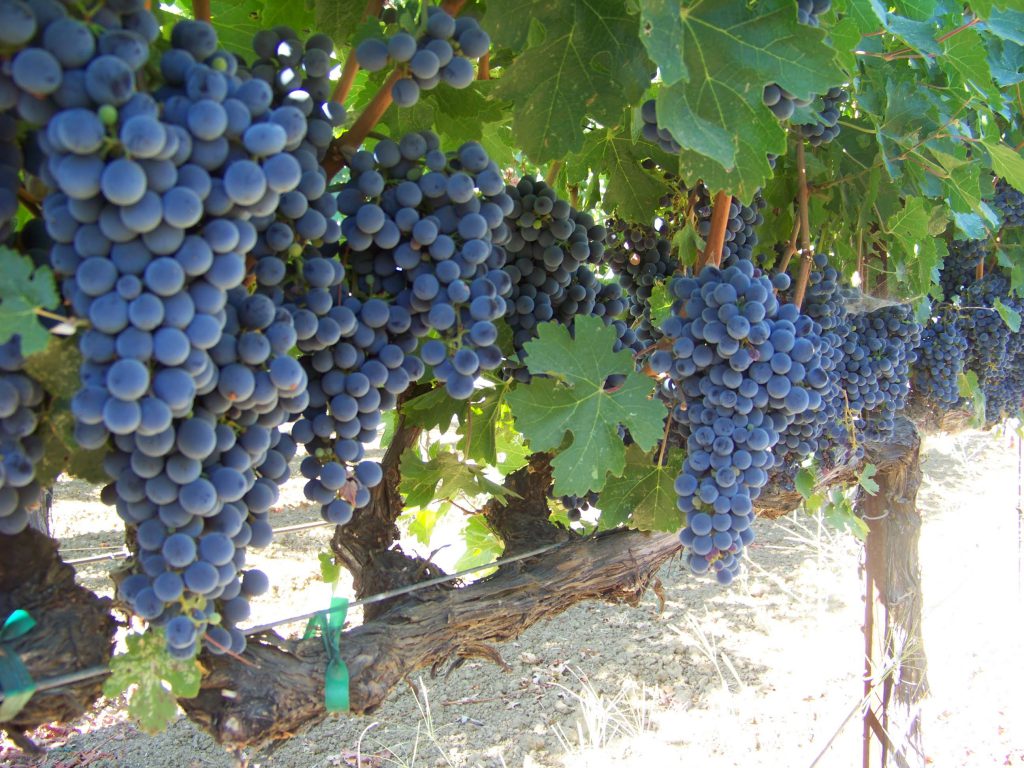
Hello Winemakers,
Excitement is in the air as we gear up for the weekend, and we couldn’t be more thrilled to have you join us on this delicious winemaking journey! It’s time to put on your winemaking hats, roll up your sleeves, and get ready to pick up your carefully nurtured grapes and juices for an extraordinary winemaking experience.
We have a few updates for you….
- Fresco California & Italian Juices: This is the LAST WEEK to Order Fresco Juices. We extended the cut off to 10/1. Get your orders in ASAP! We will have Fresco Juices from California and Italy.
- Fresh Italian Juices: We are still taking orders for Italian juices. We have a huge list of options for you to choose from! Amarone, Barolo, Brunello, Chianti, Dolchetto, Lambrusco, Montelpulciano, Moscato, Nebbiolo, Nero D’Avola, Pinot Grigio, Sangiovese, Trebbiano, and Valpolicella. They should start arriving in the first or second week in October.
- Lanza-Musto Vineyards, Suisun Valley Grapes: The Merlot should be harvested this coming weekend. We are hoping they start to deliver around 10/5. The next grapes to come off the vine will be the Malbec, Barbera, and possibly Sangiovese. We will keep you updated as these grapes start to arrive.
- Lodi Contra Costa Grapes: Many of you are waiting for the Italian grapes coming from Contra Costa. We are excited to announce that they should be arriving around 10/5.
- Lodi Mettler Ranch Grapes: The Petite Sirah, Pinot Grigio, Grenache, and Sangiovese has arrived and will continue to arrive. The Merlot is being harvested this weekend and we should see it drop somewhere around 10/5 along with a few other varieties from Mettler Ranch.
- Lodi/Central Valley Grapes: These continue to arrive every day!
- Fresh California Juices: These continue to arrive every day!
Grapes Available for Weekend Pick Up: Alicante, Cabernet, Cabernet Franc, Barbera, Black Muscat, Chardonnay, Carnelian, Grenache, Mettler Grenache, Merlot, Montepulciano, Muscat, Nero D’Avola, Tenbrink Pinot Noir, Lodi Gold Pinot Noir, Petite Sirah, Mettler Petite Sirah, Petite Verdot, Sangiovese, Mettler Sangiovese, Lanza Sauvignon Blanc, Symphony, Syrah, Thompson Seedless, and Old Vine Zinfandel.
Juices Available for Weekend Pick Up: Alicante, Barbera, Cabernet Sauvignon, Chianti, Grenache, Merlot, Mixed Black, Old Vine Zinfandel, Pinot Noir, Red Blend, Sangiovese, Zinfandel, Black Muscat (Rosé), Chardonnay, French Colombard, Pinot Grigio, and White Zinfandel (Rosé), and more!!
As you can see, we have a lot of Grapes and Juices to offer this season! Please CALL AHEAD for pick up if you have your hear set on something specific. Our stock moves in and out so quickly, we want to make sure we have everything you want and need before you make the drive!
Harvest Hours: We are open 7 days a week! Mon-Friday 7:00am-5:00PM, Sat 6:00AM-1:00PM, Sun 7:00AM-12:00PM
Winemaker In Your Pocket: Musto Wine Grape and Frank Renladi put together online courses you can access from anywhere! Check out our online classes via our sister site WinemakingInstructions.com.
There’s nothing quite like the satisfaction of sipping a glass of wine that you’ve crafted with your own hands. It’s not just a beverage; it’s a testament to your skill, dedication, and love for winemaking. Thank you for letting us be a part of your winemaking story.
Cheers!
Christina & The Musto Crush Crew
Musto Wine Grape Co. / WinemakingInstructions.com
www.juicegrape.com / 877-812-1137 / cmusto@juicegrape.com
The Italians are Coming!!
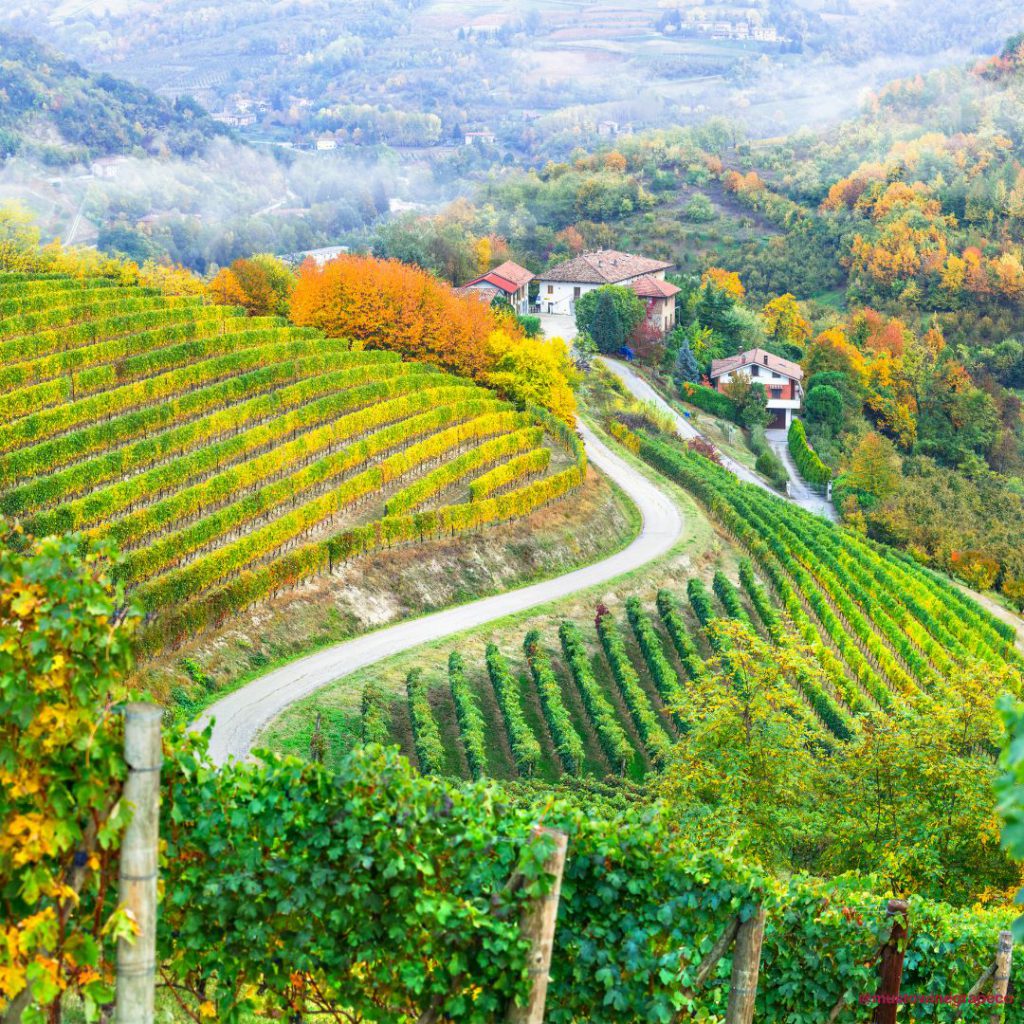
There are several compelling reasons to consider
making Italian wine from Musto’s Italian juices.
Variety:
Italy is one of the world’s largest wine producers, and it boasts an incredible variety of wine styles, grape varieties, and regions. Whether you prefer red, white, sparkling, or dessert wines, Italy offers an extensive range to explore.
Terroir:
Italy’s diverse geography, climate, and soils contribute to a rich tapestry of terroirs. Each wine region has its own unique characteristics, producing wines with distinct flavors and profiles.
Food Pairing:
Italian wines are known for their versatility and ability to complement a wide range of cuisines. Whether you’re enjoying pizza, pasta, seafood, or fine Italian cuisine, there’s an Italian wine that pairs beautifully with it.
Quality:
Italy has a long history of winemaking, and many Italian wineries are dedicated to producing high-quality wines. Italy has a significant number of prestigious wine regions and producers, including those in Tuscany, Piedmont, Puglia, and Veneto.
Heritage:
Italy has a deep cultural and historical connection to winemaking. This heritage is reflected in the traditions, techniques, and dedication of Italian winemakers.
Uniqueness:
Italy is home to several unique and iconic wine styles, such as Barolo, Amarone, Chianti, Prosecco, and Brunello di Montalcino, among others. Exploring these wines can be a delightful and enriching experience.
Whether you’re looking for a bold red wine like Barolo, a crisp white like Pinot Grigio, Italy has something to offer for every palate and occasion!
Musto Wine Grape will be receiving Italian wine juices this October! See below for a full list of what is available from Italy this fall.
Musto Wine Grape Italian Juice Offerings:
Fresh Italian Juices:
Amarone
Barolo
Brunello
Chianti
Dolchetto
Lambrusco
Montelpulciano
Moscato
Nebbiolo
Nero D’Avola
Pinot Grigio
Sangiovese
Trebbiano
Valpolicella
Italian Fresco Juices (pre-order only):
Amorosso (Amarone)
Granbarile (Barolo)
Castel del Papa
Il Toscano (Chianti)
Lambrusco
Merlot
Montelpulciano
Nebbiolo
Primitivo
Sangiovese
Pinot Grigio
Trebbiano
To make an order please contact us via sales@juicegrape.com or call us at 877-812-1137, follow us on Facebook, Instagram, and Youtube, or check out the Harvest Tracker and Winemaker Blog on our website- juicegrape.com.
Grape & Juice Availability for the weekend of 9/23-9/24
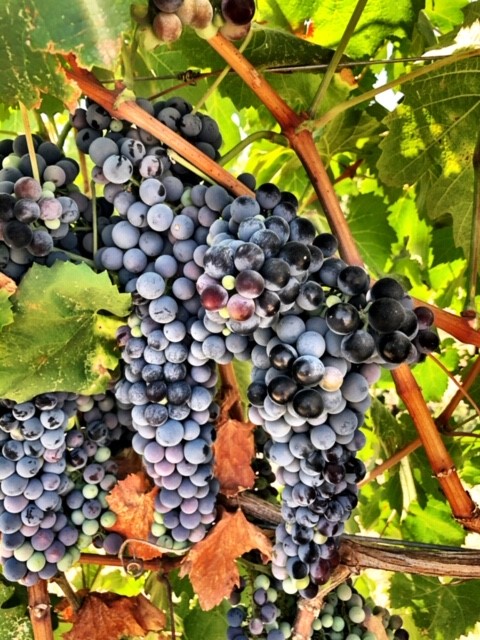
Hello Winemakers,
I hope this message finds you well. As we approach week two of the grape harvest season, I wanted to update you about our wine grape and juice options this weekend. We are excited about the quality of this year’s harvest, and we can’t wait to share it with you.
Here are the details.
Grape Varieties: ALWAYS call ahead if you have your heart set on picking up something specific.
- Albarino, Alicante, Cabernet, Cabernet Franc, Barbera, Black Muscat, Chardonnay, Grenache, Mettler Grenache, Merlot, Muscat, Petite Sirah, Mettler Petite Sirah, Petite Verdot, Sangiovese, Mettler Sangiovese, Symphony, Syrah, Thompson Seedless, and Old Vine Zinfandel.
Wine Juices: We have a great selection of wine juices with fresh pails arriving daily. We are fully stocked with our California juice pails. The Italian juices will start to arrive in the first week in October, along with the pre-order Fresco juices.
- Alicante, Barbera, Cabernet Sauvignon, Chianti, Grenache, Merlot, Mixed Black, Old Vine Zinfandel, Pinot Noir, Red Blend, Sangiovese, Zinfandel, Black Muscat (Rosé), Chardonnay, French Colombard, Pinot Grigio, and White Zinfandel (Rosé), and more!!
- Reminder: Fresco juices must be ordered by 9/25!
In case you haven’t placed your order yet or need to make any last-minute adjustments, please reach out to us as soon as possible. We want to ensure that we have everything prepared for you.
If you have any questions or need further assistance, don’t hesitate to contact us. We are looking forward to seeing you this weekend and sharing the bounty of this year’s harvest.
Thank you for choosing us as your source for wine grapes and juice. Your support means the world to us!
Cheers to another successful harvest!
Christina & The Musto Crush Crew
Musto Wine Grape Co. / WinemakingInstructions.com
www.juicegrape.com / 877-812-1137 / cmusto@juicegrape.com
Available for pick up this week (9/18-9/24)
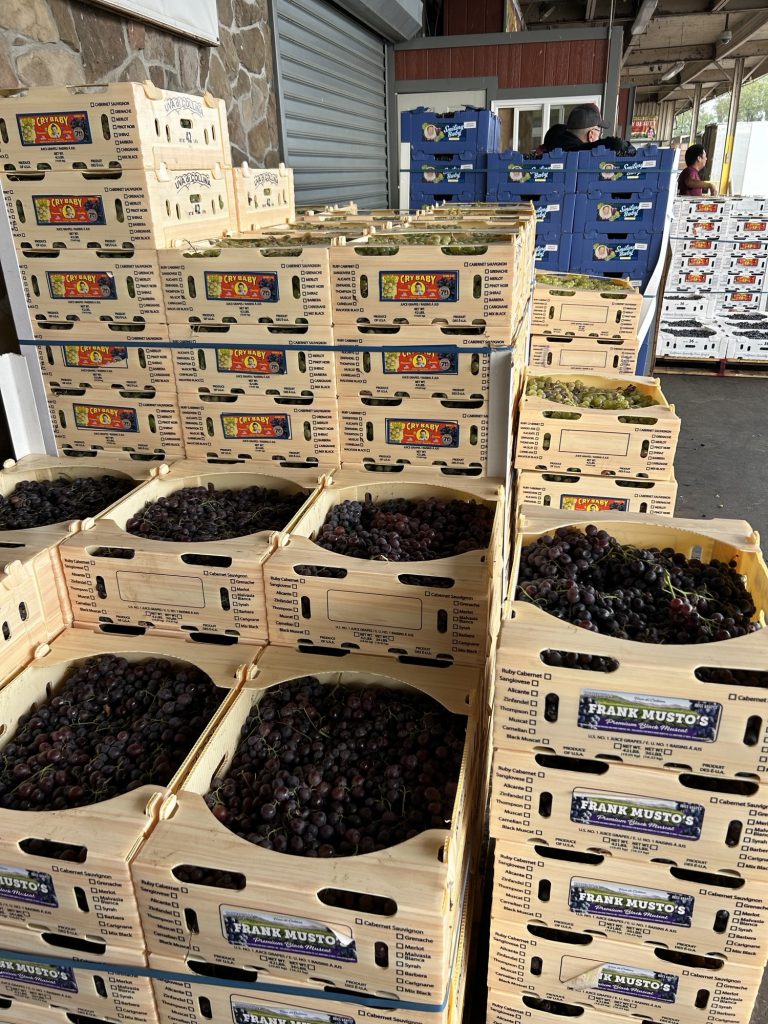
Hello Winemakers,
I hope this message finds you well. We are thrilled to share some exciting news from our vineyard as we kick off this year’s grape harvest season.
The conditions this year have been wonderful, resulting in a crop of the finest grapes we’ve seen in a long time. We wanted to give you a sneak peek into what’s happening here at Musto Wine Grape this week.
Grape Varieties: Our vineyards boasts a variety of grape types, each with its unique characteristics. This year, we have seen exceptional growth and quality across the board. From the bold and robust reds to the crisp and refreshing whites, our grapes are thriving.
- Alicante, Cabernet, Chardonnay, Barbera, Black Muscat, Grenache, Merlot, Malvasia Bianca, Muscat, Old Vine Zinfandel, Petite Sirah, Petite Verdot, Pinot Noir, Sangiovese, Symphony, Syrah, Thompson Seedless, Touriga Nacional, Zinfandel, and Zinderella
Wine Juices: We have a great selection of wine juices with fresh pails arriving daily. We are fully stocked with our California juice pails. The Italian juices will start to arrive in the first week in October, along with the pre-order Fresco juices.
- Alicante, Barbera, Cabernet Sauvignon, Chianti, Grenache, Merlot, Mixed Black, Old Vine Zinfandel, Pinot Noir, Red Blend, Sangiovese, Zinfandel, Black Muscat (Rosé), Chardonnay, French Colombard, Pinot Grigio, and White Zinfandel (Rosé), and more!!
- Reminder: Fresco juices must be ordered by 9/25!
Harvest Updates: Everything is ripening beautifully, promising an outstanding flavor profile.
- Suisun Valley will not start harvesting until the end of this week. We should start to see their grapes arrive in late September / early October. *A late addition* to the harvest menu – we will have Pinot Noir from Suisun Valley!! There are only a few boxes available. Give us a call to secure your PN today!
- Washington State Pinot Noir is harvesting this week. We might see it as early as 9/25. The Washington Cabernet, Merlot, and Cabernet Franc should start harvest in the next 2 weeks.
Produce: Every year Stevie works hard to bring you seasonally delish produce. This week we will have more Olives, Figs, and Plums available for purchase. Please call ahead if you have your heart set on anything. We will have limited quantities.
- Olives arriving 9/21
- Figs arriving 9/22
- Plums here
Winemaker In Your Pocket: Musto Wine Grape and Frank Renladi put together online courses you can access from anywhere! Check out our online classes via our sister site WinemakingInstructions.com.
- Full Winemaking Course – Over 46 videos of content!
- Online Winemaker Bootcamp
- Freebies
Our team is hard at work, carefully monitoring the grapes’ progress. We can’t wait to start turning these exceptional grapes into the finest wines! Stay tuned for more updates as the harvest progresses. We’ll be sharing behind-the-scenes glimpses, tasting notes, and more exciting news in the weeks to come.
Thank you for being a part of our journey at Musto Wine Grape. We look forward to sharing the fruits of this year’s labor with you and raising a glass together to celebrate the extraordinary flavors of our grapes.
Cheers to a bountiful harvest!
Christina & The Musto Crush Crew
Musto Wine Grape Co. / WinemakingInstructions.com
www.juicegrape.com / 877-812-1137 / cmusto@juicegrape.com
Wine Spotlight: Lanza-Musto Vineyards Malbec
Lanza-Musto Suisun Valley Malbec is a wine that brings velvety sweetness and dark complexity to the table.
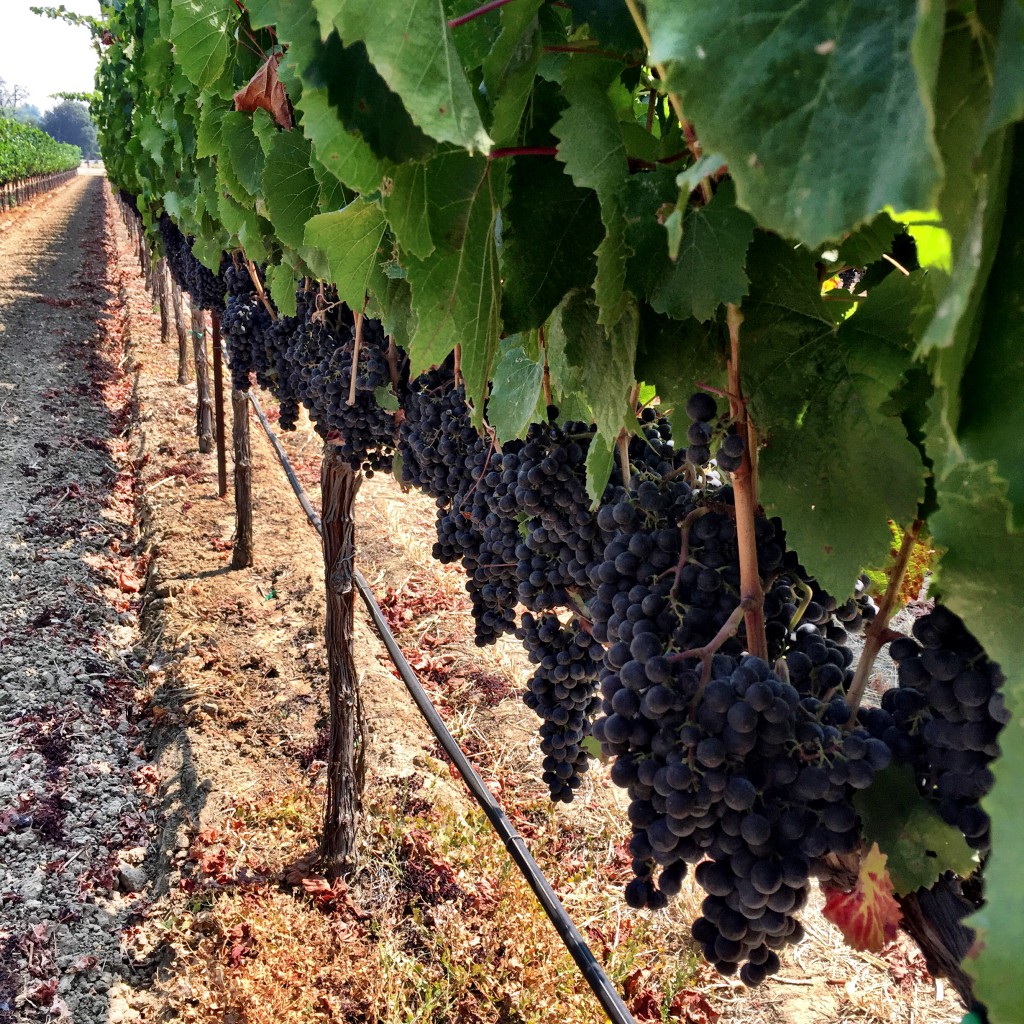
Suisun Valley, located in Solano County, California, is not traditionally known for Malbec wine production like some other regions, but it does have a small and growing reputation for producing high quality Malbec wines. If you’re considering buying Suisun Valley Malbec grapes, here are some reasons to consider:
Unique Terroir:
Suisun Valley’s terroir, characterized by its climate, soil, and topography, offers a unique and distinct environment for grape cultivation. While it may not have the recognition of regions like Argentina (known for Malbec), this uniqueness can result in wines with a different expression of the Malbec grape.
Varietal Exploration:
If you enjoy exploring different expressions of a grape variety, trying Malbec from a less common region like Suisun Valley can be an exciting adventure. It can offer a different flavor profile compared to Malbecs from more traditional regions.
Food Pairing:
Malbec is a versatile wine known for its medium to full body and rich, dark fruit flavors. Suisun Valley Malbecs can pair well with a variety of foods, including grilled meats, hearty pasta dishes, and cheeses.
Exploration:
If you’re an adventurous winemaker who enjoys exploring and discovering hidden gems, Suisun Valley Malbec can be an interesting addition to your wine collection.
Flavor Profile:
Medium bodied, mellow, fruity – raisins, fresh picked blueberries, plum, with soft, fine grained tannins, deliciously drinkable mocha notes.
Previous Season Grape Chemistry:
- Brix: 24.5
- pH: 3.29
- TA: .65gms/100ml
- Clone 9
- Planted in 2009
- Soil: Yolo, Silty Clay Loam
- VSP posititioning
To make an order please contact us via sales@juicegrape.com or call us at 877-812-1137, follow us on Facebook, Instagram, and Youtube, or check out the Harvest Tracker and Winemaker Blog on our website- juicegrape.com.
🍇🍷 Exciting News! The Black Muscat Wine Grapes Have Arrived! 🍇🍷
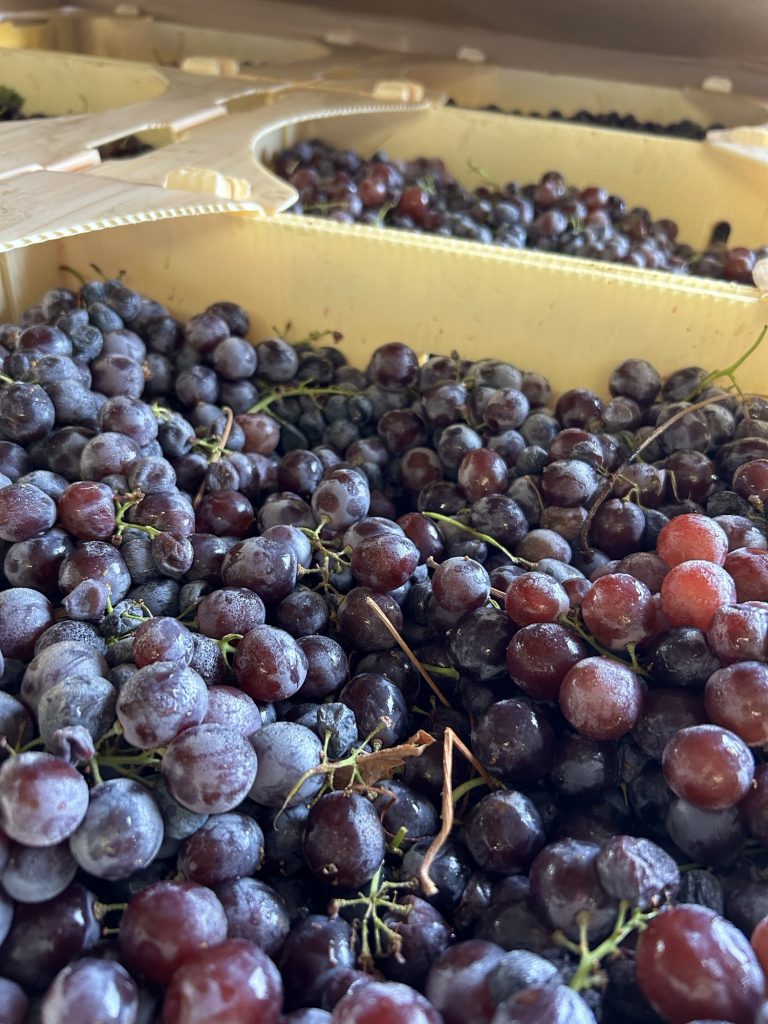
The dock is buzzing with excitement as we welcome the arrival of our beautiful Black Muscat wine grapes, ripened to perfection under the warm sun and nurtured with care.
🍇 Black Muscat
When it comes to grapes, we often think of the popular varieties like Cabernet Sauvignon, Merlot, or Zinfandel. However, tucked away in the world of vineyards is a gem that’s lesser-known but equally delightful – Black Muscat grapes. These grapes are a true delicacy, offering a unique combination of intense flavor, striking appearance, and a rich history. Black Muscat makes a fantastic sweet rosé, light red wine, and is a great base for Raki. In this post, we’ll dive into the fascinating world of Black Muscat grapes and explore what makes them so special.
🌞 A Brief History
Black Muscat grapes have their origins in the Mediterranean and are closely related to the Muscat family of grapes, known for their aromatic and sweet qualities. These grapes have a long and storied history, dating back thousands of years to ancient times when they were cultivated for wine production and used for medicinal purposes.
🍷 Flavor Profile
Black Muscat grapes are known for their stunning appearance. They are a large to medium-sized, round or oval in shape, and have a deep black or purple-black skin. When you hold a bunch of Black Muscat grapes in your hand, you can’t help but be captivated by their dark, enchanting beauty. The real magic of Black Muscat grapes lies in their flavor. These grapes are renowned for their intense aromatics and sweetness.
IN STOCK FOR THIS WEEKEND:
- Grapes: Grenache Noir, Grenache Blanc, Black Muscat, Muscat, Pinot Noir, Tempranillo, Teroldego, Barbera, Cabernet, Merlot, Zinfandel, Old Vine Zinfandel, Mettler Pinot Grigio, Mettler Grenache, Alicante, and Thompson Seedless
- Juices: Cabernet Sauvignon, Merlot, Zinfandel, Grenache, Black Muscat, Mixed Black, Petite Sirah, Pinot Noir, Ruby Cabernet, Syrah, Chardonnay, Muscat, Pinot Grigio, Riesling, Sauvignon Blanc, Thompson Seedless, Viognier, and White Zinfandel
- Always call ahead to make sure you have the most up to date stock information!
Raki & Black Muscat:
Additionally, to wine – Black Muscat is a great grape to use for the drink Raki. Raki is the National drink of Turkey. It is also a popular drink through the Baltic regions and in Albania.
Raki is a traditional alcoholic beverage that is popular in several countries, especially in the Mediterranean region, including Turkey, Greece, Albania, and parts of the Balkans. It is an anise-flavored spirit with a strong, distinctive taste. The production process of raki typically involves several steps:
- Fermentation of Grapes or Other Fruits: Raki can be made from a variety of fruits, with grapes being the most common choice. Black Muscat has gained in popularity over the years to be the preferred grape to use. The first step is to crush and juice the fruit, which is then fermented. Yeast is often added to initiate the fermentation process, converting the sugars in the fruit into alcohol. This initial fermentation usually takes a few weeks.
- Distillation: After fermentation, the liquid is distilled to increase its alcohol content. The traditional method involves using a special copper pot still called a “degirmen” in Turkey or “rakia” in Greece. The fermented fruit mash is heated, and the alcohol vapor is collected and condensed to produce a high-proof spirit. The distillation process is usually repeated to ensure a higher alcohol concentration.
- Anise Flavoring: Anise seeds or aniseed are an essential ingredient in raki production. These seeds are typically crushed or ground, and the resulting powder is added to the distilled alcohol. This gives raki its characteristic licorice-like flavor and cloudy appearance when mixed with water. The anise-flavored alcohol is allowed to rest for a period, allowing the flavors to meld.
- Dilution: Raki is typically consumed by diluting it with water, which also causes it to turn cloudy due to the anise oils becoming less soluble. The ratio of water to raki can vary according to personal preference but is often around 1:1 or 2:1 (water to raki).
- Bottling and Aging: Some raki may be aged in wooden barrels for a short period to mellow its flavors, although this is less common than with other spirits like whiskey or brandy. Once the aging process is complete, the raki is typically filtered and then bottled for sale.
It’s important to note that the production methods and ingredients may vary from one region to another, and there may be slight variations in the production process. Also, the alcoholic content of raki can vary, but it is generally around 40-45% alcohol by volume.
Enjoyed primarily as an aperitif or as an accompaniment to meals, raki has a strong cultural significance in the countries where it is popular, often being consumed during social gatherings and special occasions.
Black Muscat & Rosé:
On the nose there is passion fruit, guava, sweet strawberry, sweet cherry, and papaya. The aromatics continue through the palate with a touch of crisp acidity. As a dry wine this light bodied Rose is full of complexity and flavor. If you’re more of a sweet winemaker, adding about 1-2% Residual sugar to this wine would make for a very aromatic and balanced sweet wine.
Black Muscat Winemaking Recipe:
- Crush the Black Muscat into vat
- Add Potassium Meta to kill native yeast, let sit for 12 hours
- Add Cinn Free, stir must, let sit for another 12 hours
- Press juice after 24 hours on the skins
- Add Booster Blanc and Opti White (dilute in spring water, mix like pancake mix, dump into must, mix up)
- Pitch yeast after 24 hrs on skins, make sure juice is at 65 degrees. If not let it warm up. Use VIN13 yeast.
- Next Day: Add Fermaid O
- Monitor Brix levels daily
- At 1/3 of a drop in Brix (10-8 Brix) add Fermaid K
Please Note:
The color might be light. It darkened up over time. And if it doesn’t darken up enough to your liking, I have some “pixie dust” that will help with the color during the aging process. Also, after fermentation I added Noblesse at my first racking. This is because I thought the acid was a little high and it helped soften the mouthfeel. Every year is different, so you might not need to do this. Taste it after fermentation and then decide.
If you are interested in making Black Muscat wine and having any questions please feel free to reach out to our winemaking professionals via phone or email – 877-812-1137 or sales@juicegrape.com.
Don’t forget about our Winemaking Classes…
Hands-On Winemaking: Back by popular demand is our Winemaker Bootcamp. The September Class will start Saturday September 16th, 2023 at 9:00AM – 12:00PM (runs for 5 weeks). The October Class will start on Saturday October 21st, 2023 at 9:00AM – 12:00PM (runs for 5 weeks). Make sure to sign up via the website or email cmusto@juicegrape.com if you are interested. There is only 1 space left in the September class and only 2 spaces left in the October class!
Winemaker In Your Pocket: Musto Wine Grape and Frank Renladi put together online courses you can access from anywhere! Check out our online classes via our sister site WinemakingInstructions.com.
We look forward to seeing you at pick up this season! 😊
Cheers!
Christina & The Musto Crush Crew
Musto Wine Grape Co. / WinemakingInstructions.com
The most anticipated time of the year is finally upon us – Wine Season is HERE!
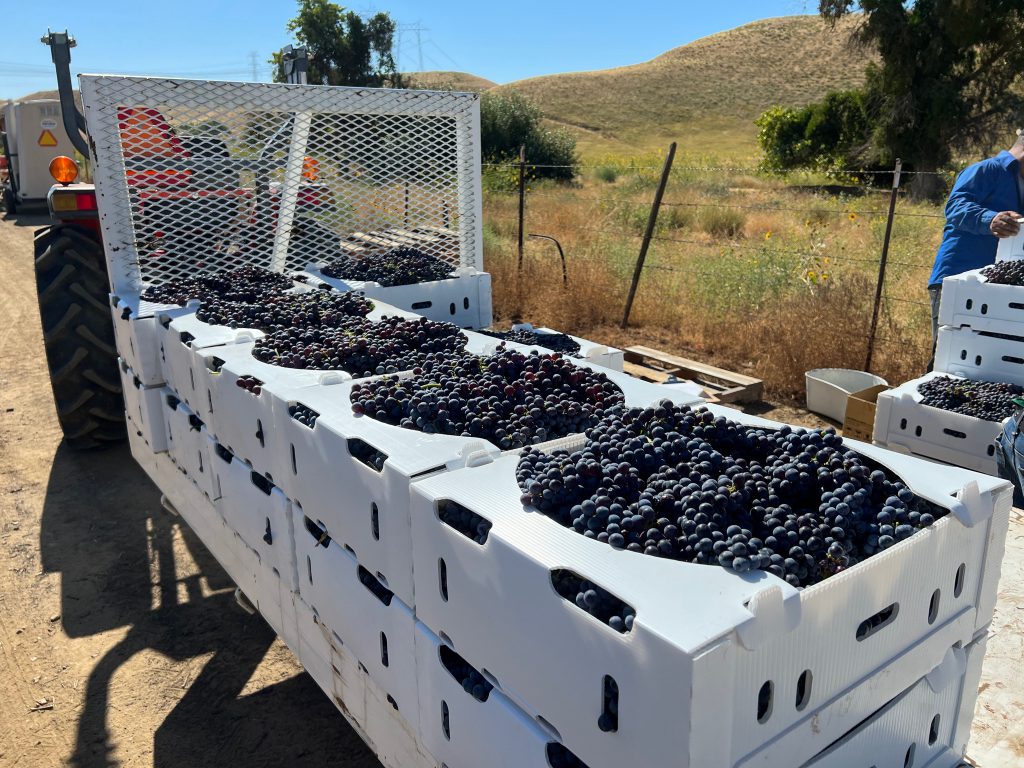
Hello Winemakers,
I’m sure you are itching to get back into the winemaking process. It’s the most exciting time of year in our opinion!
The art of winemaking is truly remarkable and allows us to witness transformative magic unfolding right before our eyes. Just imagine the symphony of aromas that will fill the air as the grapes are crushed, releasing their juices, and bringing forth the promise of a beautiful vintage. Picture the vibrant colors dancing in the fermenters, as the yeasts work their magic, transforming sugar into alcohol. And oh, the joy of witnessing the first bubbles forming during fermentation, a sure sign that our wine is well on its way.
With every batch, we have the opportunity to experiment and refine our craft, constantly pushing the boundaries of what is possible in winemaking. Get excited to make a wine you will love this season!
Here’s what you can look forward to this week:
*If there is something you have your heart set on, please call ahead
- Grapes & Juices Arriving by 9/15:
- Juices: Alicante, Barbera, Cabernet Sauvignon, Chianti, Grenache, Merlot, Mixed Black, Old Vine Zinfandel, Pinot Noir, Red Blend, Sangiovese, Zinfandel, Black Muscat (Rosé) Chardonnay, French Colombard, Pinot Grigio, and White Zinfandel (Rosé).
- Grapes: Grenache, Merlot, Old Vine Zinfandel, Syrah, Teroldego, Black Muscat, Chardonnay, Fiano, Pinot Grigio, Sauvignon Blanc, Thompson Seedless, and Vermentino.
- Olives: Stevie “The Olive King” has secured the green olives for this season. He is bringing in big and small sizes, each in 16lb cases. We will have limited stock so please call ahead before you drive down. They should arrive by Friday 9/15.
- Winemaker Hours: Winemaker Sam is on vacation until September 15th. But Winemaker Barry will be in on Tuesdays, Fridays, and Saturdays to assist you with your fermentation and winemaking questions.
- Harvest Store Hours: We are officially open 7 days a week! Mon-Friday 7:00am-5:00PM, Sat 6:00AM-1:00PM, Sun 7:00AM-12:00PM
- New York/New Jersey Pick Up: D’Arrigo will be a pickup location for us in the Bronx, NY. You can pre-order with MWG and pick up your order closer to home! Ask your sales representative for more details.
- Delivery Services: MWG has an extensive delivery network. If you are interested in delivery, please ask your sales representative for more details.
- Currently In Stock (as of 9/11):
- Grapes: Grenache Noir, Grenache Blanc, Muscat, Pinot Noir, Tempranillo, Teroldego, Barbera, Alicante, and Thompson Seedless
- Juices: Cabernet Sauvignon, Merlot, Zinfandel, Grenache, Mixed Black, Petite Sirah, Pinot Noir, Ruby Cabernet, Syrah, Chardonnay, Muscat, Pinot Grigio, Riesling, Sauvignon Blanc, Thompson Seedless, Viognier, and White Zinfandel
- Always call ahead to make sure you have the most up to date stock information!
Looking ahead to Next Week:
Harvest Updates: Suisun Valley Sauvignon Blanc is around 22 Brix and the Brunello Clone Sangiovese is around 21 Brox. We should see Suisun Valley fruit start to harvest towards the end of September. Lodi will start to harvest more Cabernet, Zinfandel, and Merlot this week. Central Valley harvest is in full swing and will be arriving daily. Washington State Pinot Noir should start to come off the vine around 9/16, and arrive around 9/22. The Fresco Juice order deadline is 9/25 and they should start arriving the first week in October. Italian juices are set to delivery in the first week in October.
Don’t forget about our Winemaking Classes…
Hands-On Winemaking: Back by popular demand is our Winemaker Bootcamp. The September Class will start Saturday September 16th, 2023 at 9:00AM – 12:00PM (runs for 5 weeks). The October Class will start on Saturday October 21st, 2023 at 9:00AM – 12:00PM (runs for 5 weeks). Make sure to sign up via the website (link: 5 Week Winemaking Bootcamp (juicegrape.com)) or email cmusto@juicegrape.com if you are interested. There is only 1 space left in the September class and only 2 spaces left in the October class!
Winemaker In Your Pocket: Musto Wine Grape and Frank Renladi put together online courses you can access from anywhere! Check out our online classes via our sister site WinemakingInstructions.com {link: Learn How to Make Your Own Wine (winemakinginstructions.com)).
We look forward to seeing you at pick up this season! 😊
Cheers!
Christina & The Musto Crush Crew
Musto Wine Grape Co. / WinemakingInstructions.com
cmusto@juicegrape.com







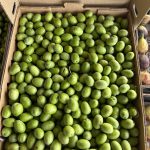
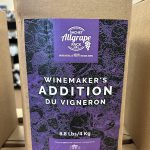
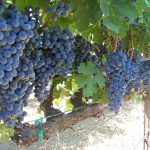
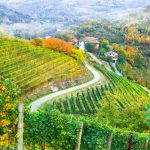
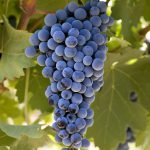
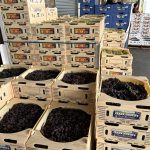
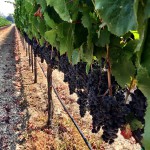
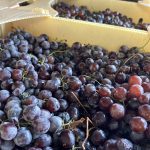
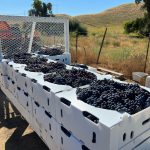
Recent Comments